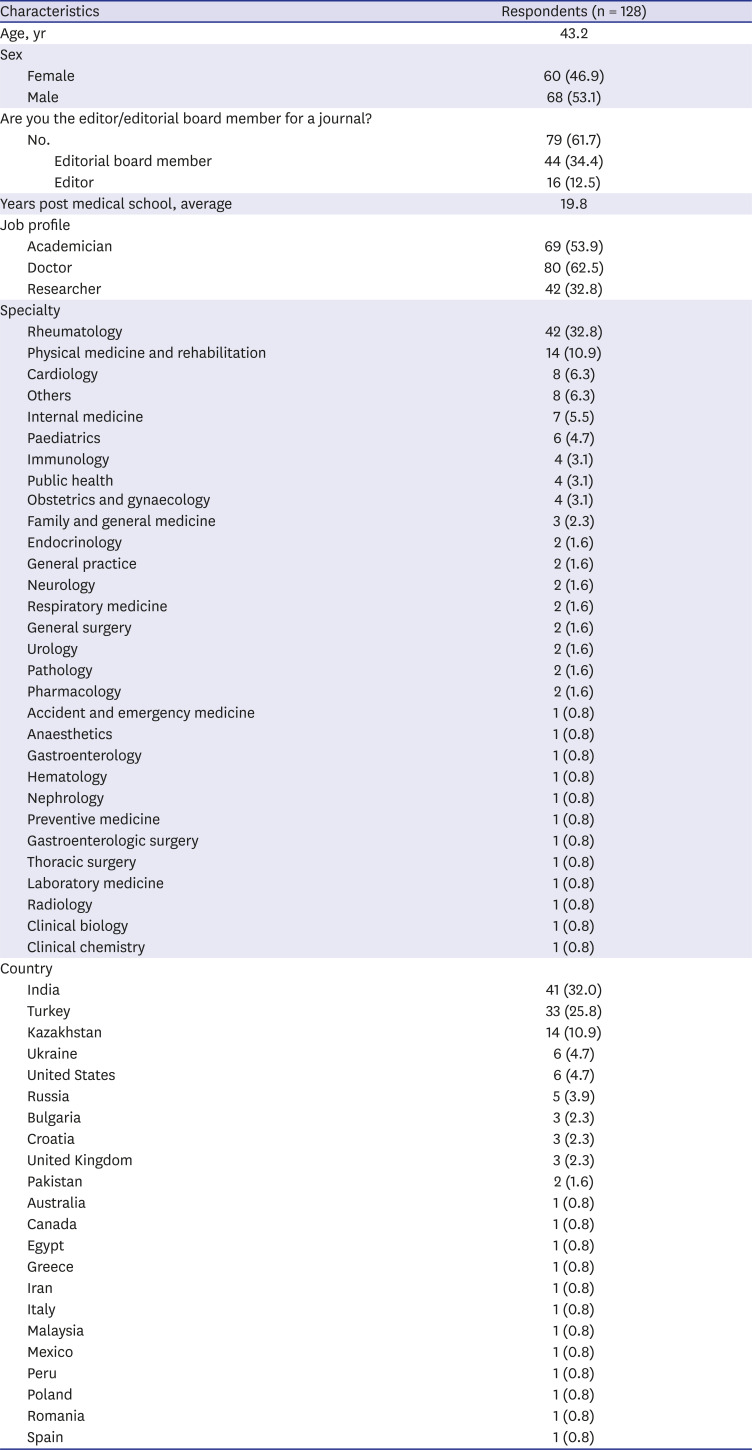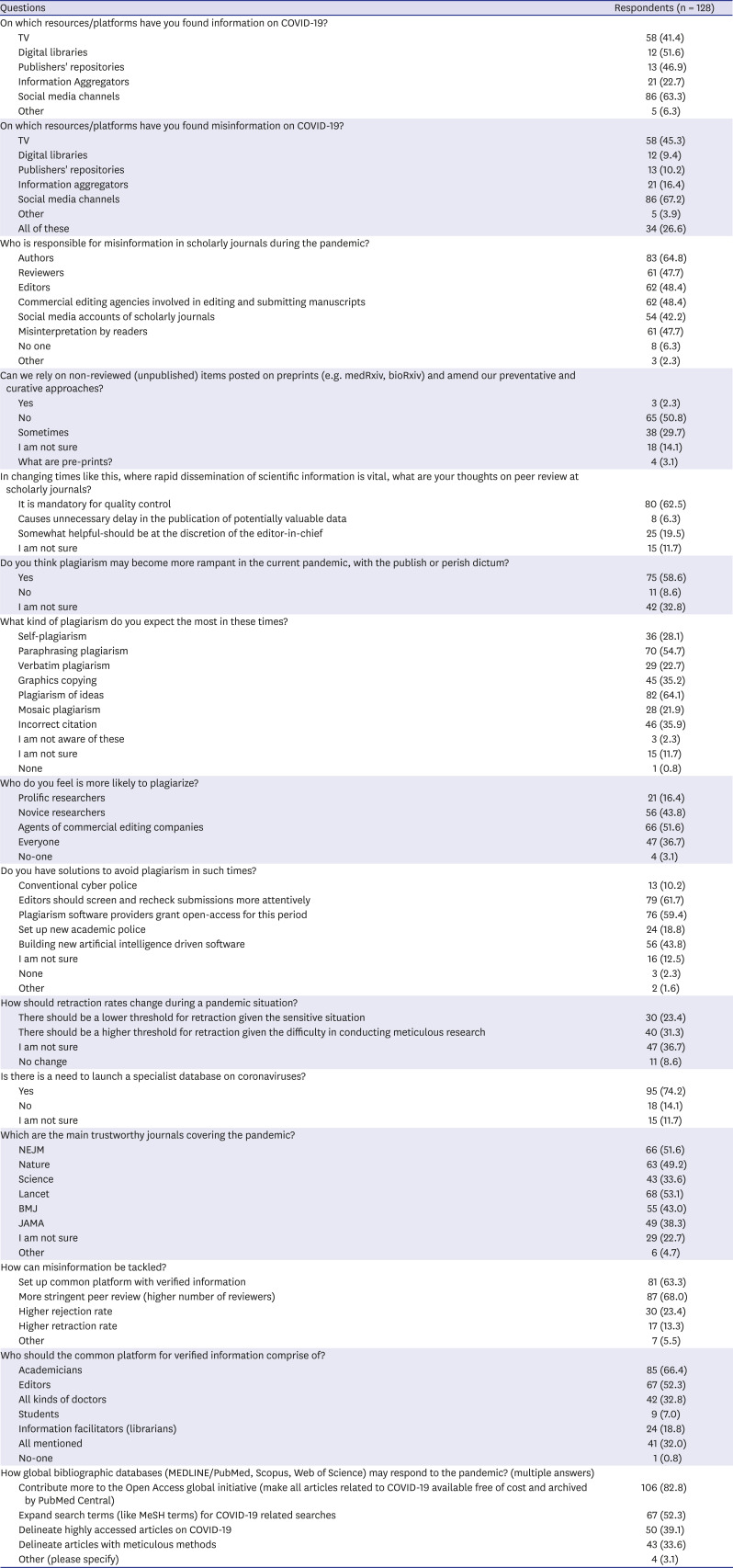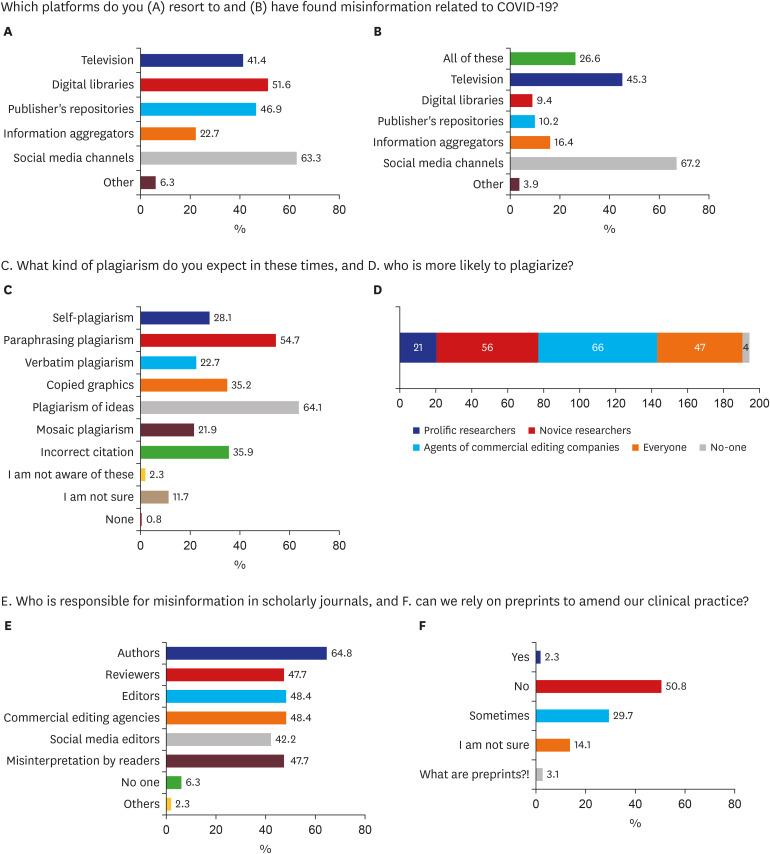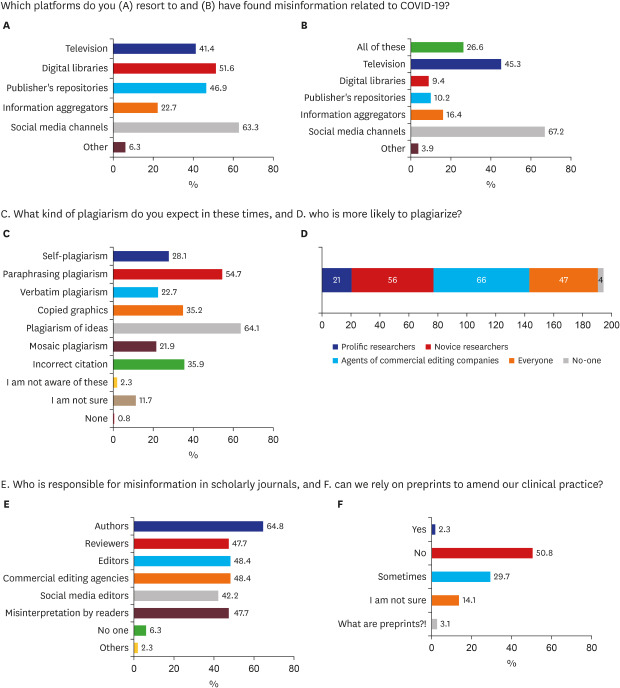INTRODUCTION
The coronavirus disease 2019 (COVID-19) pandemic and consequent need for boosting immunity and following hygiene and social distancing regulations to mitigate infection risks have led researchers, clinicians and journal editors around the world to search for rational hypotheses, ideas, and emerging evidence for prevention and management of this new disease.
12 While established scholarly platforms continue publishing and disseminating peer-reviewed and validated items on the new coronavirus, numerous online channels with variable quality checks are emerging and supplying their users with statements, instructions, and recommendations on various aspects of COVID-19.
3 The scarcity of highly skilled professionals, primarily physicians with diverse interests in virology, immunology and thrombology, capable of moderating the unprecedented flow of information via the established and alternative communication channels paves the way for circulation of poorly checked and misleading hypotheses, ideas, and research outcomes. While lay public and professionals scramble to gather more about the current situation, the massive flux of unverified information creates uncertainties due to the infodemic and risks thousands of lives globally.
45
Apart from a large volume of publications on COVID-19, a barrage of non-reviewed preprints on various professional repositories and a slew of retractions amplify the confusion further.
6 Amid the urge to obtain more research results on the new coronavirus and prevention and management of COVID-19, on the background of the mass proliferation of related articles, experts have raised concerns over the deficiencies in the whole process of research management and publishing in these challenging times.
7 By adversely impacting prevention and management of COVID-19, poorly managed research and publishing enterprise carry lasting implications for the trustworthiness of scholarly communication channels. Journal editors may take the lead by responsibly processing medical information on COVID-19, ethically promoting relevant items on social media, and contributing to the accumulation of evidence base.
5 With this in mind, we aimed to explore potential sources of information and misinformation on COVID-19 by distributing a questionnaire on the role of social media attention notes, published and unpublished items, peer review, and post-publication quality checks among researchers, clinicians, and academics.
Go to :

METHODS
Questionnaire design
Our questionnaire featured 22 questions, 19 of which were multiple choice. The survey was designed to arrive at the resources of information and misinformation (4), preprint archiving (1), peer review (1), plagiarism (4), retractions (1) and probable solutions (4) for improved publication methods and ethics. Seven questions aimed to characterize the respondent populations demographic profile (2), expertise (4) and location (1). All individuals from the authors' team participated in the assessment of the rationale of the survey and face-validity. Following this, the final survey was preliminarily filled by three individual respondents to identify mistakes in wording, grammar or syntax, and critically evaluate the modifications from the original survey. The questionnaire underwent nine rounds of revisions. The average survey time was five minutes. The respondents could change the answers before submission but not after it. All questions were mandatory. The survey was completely anonymized.
Population selection
The questionnaire was widely disseminated over social-media platforms (Twitter, Facebook and WhatsApp) with the hashtags #misinformation and #COVID-19 to be voluntarily filled by researchers, clinicians, academics, and journal editors. The survey e-link was distributed via the official social media accounts of the Indian J Rheumatol. There was no particular sampling technique used, and all those who agreed to participate were included in the survey. The eligible participants were given three weeks to voluntarily complete the questionnaire from May 22 to June 13, 2020. Informed consent was taken at the beginning of the survey, and no incentives were offered for survey completion.
Ethics statement
An exemption from review was obtained from the institute ethics committee of Sanjay Gandhi Postgraduate Institute of Medical Sciences, Lucknow, India as per local guidelines (2020-110-IP-EXP-16).
3 We adhered to the Checklist for Reporting Results of Internet E-surveys to report the data.
8
Go to :

RESULTS
Among 128 respondents (mean age, 43.2 years; M:F, 1.1:1), 60 (46.9%) were scholarly journal editors and editorial board members. Sixty-nine (54%) were academics, and 42 (33%) were researchers. Nearly one-third (32.8%) were rheumatologists, with a sizable representation from India (41, 32%), Turkey (33, 25.8%) and Kazakhstan (14, 11%) (
Table 1).
Table 1
Coronavirus disease 2019 information and misinformation survey respondent characteristics

|
Characteristics |
Respondents (n = 128) |
|
Age, yr |
43.2 |
|
Sex |
|
|
Female |
60 (46.9) |
|
Male |
68 (53.1) |
|
Are you the editor/editorial board member for a journal? |
|
|
No. |
79 (61.7) |
|
|
Editorial board member |
44 (34.4) |
|
|
Editor |
16 (12.5) |
|
Years post medical school, average |
19.8 |
|
Job profile |
|
|
Academician |
69 (53.9) |
|
Doctor |
80 (62.5) |
|
Researcher |
42 (32.8) |
|
Specialty |
|
|
Rheumatology |
42 (32.8) |
|
Physical medicine and rehabilitation |
14 (10.9) |
|
Cardiology |
8 (6.3) |
|
Others |
8 (6.3) |
|
Internal medicine |
7 (5.5) |
|
Paediatrics |
6 (4.7) |
|
Immunology |
4 (3.1) |
|
Public health |
4 (3.1) |
|
Obstetrics and gynaecology |
4 (3.1) |
|
Family and general medicine |
3 (2.3) |
|
Endocrinology |
2 (1.6) |
|
General practice |
2 (1.6) |
|
Neurology |
2 (1.6) |
|
Respiratory medicine |
2 (1.6) |
|
General surgery |
2 (1.6) |
|
Urology |
2 (1.6) |
|
Pathology |
2 (1.6) |
|
Pharmacology |
2 (1.6) |
|
Accident and emergency medicine |
1 (0.8) |
|
Anaesthetics |
1 (0.8) |
|
Gastroenterology |
1 (0.8) |
|
Hematology |
1 (0.8) |
|
Nephrology |
1 (0.8) |
|
Preventive medicine |
1 (0.8) |
|
Gastroenterologic surgery |
1 (0.8) |
|
Thoracic surgery |
1 (0.8) |
|
Laboratory medicine |
1 (0.8) |
|
Radiology |
1 (0.8) |
|
Clinical biology |
1 (0.8) |
|
Clinical chemistry |
1 (0.8) |
|
Country |
|
|
India |
41 (32.0) |
|
Turkey |
33 (25.8) |
|
Kazakhstan |
14 (10.9) |
|
Ukraine |
6 (4.7) |
|
United States |
6 (4.7) |
|
Russia |
5 (3.9) |
|
Bulgaria |
3 (2.3) |
|
Croatia |
3 (2.3) |
|
United Kingdom |
3 (2.3) |
|
Pakistan |
2 (1.6) |
|
Australia |
1 (0.8) |
|
Canada |
1 (0.8) |
|
Egypt |
1 (0.8) |
|
Greece |
1 (0.8) |
|
Iran |
1 (0.8) |
|
Italy |
1 (0.8) |
|
Malaysia |
1 (0.8) |
|
Mexico |
1 (0.8) |
|
Peru |
1 (0.8) |
|
Poland |
1 (0.8) |
|
Romania |
1 (0.8) |
|
Spain |
1 (0.8) |

Social media channels were distinguished as the most important sources of information and, at the same time, misinformation by 81 (63.3%) and 86 (67.2%) respondents, respectively. Digital libraries and publishers' repositories constituted the other most important sources of information on COVID-19. Nearly half (45.3%) found misinformation on television. While two-third respondents (83, 64.8%) felt that scientific authors themselves are responsible for misinformation in scholarly journals. Almost two in five (62, 48.4%) respondents blamed reviewers, editors, and misinterpretation by readers as additional contributors to misinformation (
Table 2).
Table 2
Analysis of survey results on COVID-19 information and misinformation

|
Questions |
Respondents (n = 128) |
|
On which resources/platforms have you found information on COVID-19? |
|
|
TV |
58 (41.4) |
|
Digital libraries |
12 (51.6) |
|
Publishers' repositories |
13 (46.9) |
|
Information Aggregators |
21 (22.7) |
|
Social media channels |
86 (63.3) |
|
Other |
5 (6.3) |
|
On which resources/platforms have you found misinformation on COVID-19? |
|
|
TV |
58 (45.3) |
|
Digital libraries |
12 (9.4) |
|
Publishers' repositories |
13 (10.2) |
|
Information aggregators |
21 (16.4) |
|
Social media channels |
86 (67.2) |
|
Other |
5 (3.9) |
|
All of these |
34 (26.6) |
|
Who is responsible for misinformation in scholarly journals during the pandemic? |
|
|
Authors |
83 (64.8) |
|
Reviewers |
61 (47.7) |
|
Editors |
62 (48.4) |
|
Commercial editing agencies involved in editing and submitting manuscripts |
62 (48.4) |
|
Social media accounts of scholarly journals |
54 (42.2) |
|
Misinterpretation by readers |
61 (47.7) |
|
No one |
8 (6.3) |
|
Other |
3 (2.3) |
|
Can we rely on non-reviewed (unpublished) items posted on preprints (e.g. medRxiv, bioRxiv) and amend our preventative and curative approaches? |
|
|
Yes |
3 (2.3) |
|
No |
65 (50.8) |
|
Sometimes |
38 (29.7) |
|
I am not sure |
18 (14.1) |
|
What are pre-prints? |
4 (3.1) |
|
In changing times like this, where rapid dissemination of scientific information is vital, what are your thoughts on peer review at scholarly journals? |
|
|
It is mandatory for quality control |
80 (62.5) |
|
Causes unnecessary delay in the publication of potentially valuable data |
8 (6.3) |
|
Somewhat helpful-should be at the discretion of the editor-in-chief |
25 (19.5) |
|
I am not sure |
15 (11.7) |
|
Do you think plagiarism may become more rampant in the current pandemic, with the publish or perish dictum? |
|
|
Yes |
75 (58.6) |
|
No |
11 (8.6) |
|
I am not sure |
42 (32.8) |
|
What kind of plagiarism do you expect the most in these times? |
|
|
Self-plagiarism |
36 (28.1) |
|
Paraphrasing plagiarism |
70 (54.7) |
|
Verbatim plagiarism |
29 (22.7) |
|
Graphics copying |
45 (35.2) |
|
Plagiarism of ideas |
82 (64.1) |
|
Mosaic plagiarism |
28 (21.9) |
|
Incorrect citation |
46 (35.9) |
|
I am not aware of these |
3 (2.3) |
|
I am not sure |
15 (11.7) |
|
None |
1 (0.8) |
|
Who do you feel is more likely to plagiarize? |
|
|
Prolific researchers |
21 (16.4) |
|
Novice researchers |
56 (43.8) |
|
Agents of commercial editing companies |
66 (51.6) |
|
Everyone |
47 (36.7) |
|
No-one |
4 (3.1) |
|
Do you have solutions to avoid plagiarism in such times? |
|
|
Conventional cyber police |
13 (10.2) |
|
Editors should screen and recheck submissions more attentively |
79 (61.7) |
|
Plagiarism software providers grant open-access for this period |
76 (59.4) |
|
Set up new academic police |
24 (18.8) |
|
Building new artificial intelligence driven software |
56 (43.8) |
|
I am not sure |
16 (12.5) |
|
None |
3 (2.3) |
|
Other |
2 (1.6) |
|
How should retraction rates change during a pandemic situation? |
|
|
There should be a lower threshold for retraction given the sensitive situation |
30 (23.4) |
|
There should be a higher threshold for retraction given the difficulty in conducting meticulous research |
40 (31.3) |
|
I am not sure |
47 (36.7) |
|
No change |
11 (8.6) |
|
Is there is a need to launch a specialist database on coronaviruses? |
|
|
Yes |
95 (74.2) |
|
No |
18 (14.1) |
|
I am not sure |
15 (11.7) |
|
Which are the main trustworthy journals covering the pandemic? |
|
|
NEJM |
66 (51.6) |
|
Nature |
63 (49.2) |
|
Science |
43 (33.6) |
|
Lancet |
68 (53.1) |
|
BMJ |
55 (43.0) |
|
JAMA |
49 (38.3) |
|
I am not sure |
29 (22.7) |
|
Other |
6 (4.7) |
|
How can misinformation be tackled? |
|
|
Set up common platform with verified information |
81 (63.3) |
|
More stringent peer review (higher number of reviewers) |
87 (68.0) |
|
Higher rejection rate |
30 (23.4) |
|
Higher retraction rate |
17 (13.3) |
|
Other |
7 (5.5) |
|
Who should the common platform for verified information comprise of? |
|
|
Academicians |
85 (66.4) |
|
Editors |
67 (52.3) |
|
All kinds of doctors |
42 (32.8) |
|
Students |
9 (7.0) |
|
Information facilitators (librarians) |
24 (18.8) |
|
All mentioned |
41 (32.0) |
|
No-one |
1 (0.8) |
|
How global bibliographic databases (MEDLINE/PubMed, Scopus, Web of Science) may respond to the pandemic? (multiple answers) |
|
|
Contribute more to the Open Access global initiative (make all articles related to COVID-19 available free of cost and archived by PubMed Central) |
106 (82.8) |
|
Expand search terms (like MeSH terms) for COVID-19 related searches |
67 (52.3) |
|
Delineate highly accessed articles on COVID-19 |
50 (39.1) |
|
Delineate articles with meticulous methods |
43 (33.6) |
|
Other (please specify) |
4 (3.1) |

Nearly half (50.8%) felt that preprints could not be relied upon to change COVID-19 management practices, though another 30% opined that an exception could be made sometimes. A total of 80 (62.5%) affirmed that peer review is a mandatory system for prepublication checks despite the need for fast processing and dissemination of scholarly articles on COVID-19. Furthermore, 70 (58.6%) perceived the risk of more frequent plagiarism in the time of crisis, with plagiarism of ideas (64.1%) followed by inappropriate paraphrasing (54.7%) being the most likely. Commercial editing agents and novice authors were pointed out as the most likely offenders by 51.6% and 43.8% respondents, respectively (
Fig. 1).
 | Fig. 1
Perception of sources of misinformation, plagiarism, and reliability of preprints by physicians and academics.
COVID-19 = coronavirus disease 2019.

|
More stringent screening by journal editors (61.7%) and facilitating open access plagiarism software (59.4%) were the suggested solutions. A little less than half, 43.8%, proposed Artificial Intelligence (AI)-driven software algorithms. One in five (18.8%) proposed establishing academic police network for the task, while 10.1% felt conventional cyber police should do so (
Fig. 1).
The opinion on changing retraction practices during this period was divided, with 23.4% proposing lower threshold, 31.3% suggesting otherwise, and another 36.7% being not sure. Most (74.2%) supported the need to launch a specialist bibliographic database for COVID-19, with information indexed (62.3%) after due verification. More stringent peer review, by seeking evaluations of a higher number of reviewers was proposed by 68%, though higher rejection and retraction rates were supported by 23.4% and 13.3%, respectively. Nearly two-thirds (66.4%) believed that academics could constitute the platform for verified information, in addition to journal editors (52.3%), while 32% thought all clinicians could form it. A mere 7% supported the presence of students on this platform (
Fig. 1).
Respondents were of the opinion that global bibliographic databases may respond to the COVID-19 pandemic by contributing more to the Open Access global initiative (82.8%), expanding search terms (52.3%), and delineating the highly accessed articles (39.1%), particularly those with meticulous methodology (33.6%). The Lancet was highlighted as the most trustworthy scholarly journal covering COVID-19 issues by 68 (53.1%) responders, followed by the N Engl J Med (66, 51.6%) and Nature (63, 49.2%).
Go to :

DISCUSSION
In our survey comprising a large proportion of journal editors, social media channels were deemed the most common resource on COVID-19, albeit with the greatest potential for misinformation. While the opinion on preprints and retraction practices was divided, peer review was deemed mandatory in view of the heightened risk of plagiarism of ideas and inappropriate paraphrasing in this period.
Although most peer-reviewed journals have embarked on fast-track processing of COVID-19 submissions, pre-publication archiving at various preprint servers is also encouraged by large publishers to prioritize and avoid delays in dissemination of potentially valuable scientific hypotheses and research results. Praised as essential tools of the Open Access initiative,
9 countless specialist preprint platforms have emerged over the past few months, with medRxiv.org and bioRxiv.org becoming the main hubs of unpublished reports and opinion pieces on COVID-19. Some, but not all of these items, enter the peer review and get published in scholarly journals. Traditionally, unpublished sources are not recommended for citations to ensure the validity of references.
10 Nonetheless, preprints are exponentially increasing and actively attracting social media mentions and citations, at times giving a false impression of the global scholarly community approval.
1112
Preprint servers offer formatting and digital object identifier tags to improve the cross-referencing. But experts still point to incomplete reporting and poor editing at these servers, disseminating potentially dangerous news on antiviral and antimalarial drugs.
13 Unsurprisingly, our survey revealed negative attitude toward preprints among 51% of respondents. Of the various solutions offered by our respondents, organizing a trustworthy COVID-19 database and promoting the Open Access global initiative were supported by a majority.
This pandemic has witnessed numerous instances of publication ethics violations,
14 possibly due to poor understanding of the ethical norms. This deluge of information on COVID-19 has brought alongside enormous volumes of misinformation. The WHO recently collaborated with the UK government to run an awareness campaign regarding the risks of incorrect and false information related to COVID-19.
15
Nature recently acknowledged that scientists are well placed to regulate the situation, although it may amount to a time-consuming and arduous task.
2 Experts opined that the ubiquity and popularity of social media platforms suggest that the subscribers do not just passively absorb them. Instead, misinformation is actively created, modified, and disseminated, lending this infodemic a unique and greatly amplified dynamic. This situation is distinctively more challenging than ever encountered while fighting previous pandemics.
16
Scientific facts and oddities may amount to a significant lack of consensus in certain domains and interpreting these as binary variables may cause the lay public as well as scientists to be misled, and amount to falsehood. However, a disaster of such magnitude also requires humankind to be well-informed in the preparedness of the times ahead. Thus, actively seeking correct information, verifying it, and curating it for dissemination to appropriate sections of the society assumes an important role. Publications in journals may be the best platform, to begin with, with more stringent checks at the portals of regulation by involving closer scrutiny by journal editors and a larger number of reviewers. Social media editors may also play a role by selectively promoting the most trustworthy articles which are free of any conflicts of interest.
5
Some of the most popular articles on COVID-19 that supported the use of hydroxychloroquine as a “magic bullet” have been recently retracted
17 and raised concerns over the quality of peer review at leading evidence-based journals. Even a single such retraction may disorient authors and readers in this time of the pandemic.
18 Most respondents of our survey agreed that journal editors and reviewers share the responsibility with authors for misinformation in poorly checked manuscripts. While reviewing is usually a voluntary activity by motivated scholars, distinct provision of time and added incentives for the effort may turn it into a more gainful exercise.
19 Self-cleansing of falsified information as errata is the therapeutic choice when preventative measures fail. Re-publishing the correct information among erroneous or falsified data is another grey area.
20
The massive overload of information also brings in the risk of plagiarism. AI-based tools are proposed for both detecting plagiarism and data mining through databases. StatReviewer, an AI algorithm identified errors missed by human reviewers, suggesting a role in complementing review.
21 Various algorithms have been developed for paraphrasing plagiarized phrases and passages of text, using semantic word normalization and refinement for plagiarisms in a multilingual environment.
22 It may seem plausible to explore their role as the screening algorithm for identifying papers that may not need to go into peer review, saving human effort.
21
To avoid lay public and doctors being misguided by falsehoods, it may be prudent to embark on planning how to monitor platforms with the greatest flux of information among an ever-expansive audience. Social media use is rampant among clinicians, with certain platforms such as WhatsApp being more popular in some countries, and Twitter across most developed and Anglophone countries.
2324 This may require collaborations with techie enterprises, such as WhatsApp, which have launched a chatbox together with the International Fact-Checking Network (IFCN) to identify misinformation.
25 Furthermore, contributions from databases toward the Open Access initiative may further facilitate the availability of scholarly articles for wider dissemination and post-publication commenting. Expanding search terms can enhance visibility and be useful for appropriate classification while delineating the items with meticulous methods can set the bar for quality as well as segregate literature resource for comparisons using manual and AI-driven approaches.
16
Finally, it is necessary to discuss potential limitations of the study caused by a relatively short period of survey and a relatively small sample size. However, unique insights of this pilot study may pave the way for a larger and a more diversified global study. The strength of our survey is that nearly half of the respondents were associated with journal editing, lending greater credibility to the academic observations.
In conclusion, social media channels and television are currently believed to be the main sources of misinformation on COVID-19. Perceived high risk of plagiarism warrants more stringent peer review by scarcely available scholars. There is an urgent need for highly skilled scholars to assume a greater role in moderating information flow on COVID-19 via established and emerging platforms for scholarly communication.
Go to :







 PDF
PDF Citation
Citation Print
Print





 XML Download
XML Download